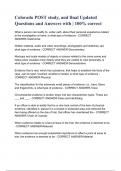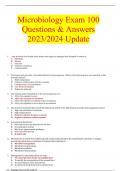Exam (elaborations)
The NASPGHAN Fellows Concise Review of Pediatric Gastroenterology, Hepatology and Nutrition Section 16 Questions and Answers Latest Verified Review 2023 Practice Questions and Answers for Exam Preparation, 100% Correct with Explanations, Highly Recommende
- Course
- Institution
The NASPGHAN Fellows Concise Review of Pediatric Gastroenterology, Hepatology and Nutrition Section 16 Questions and Answers Latest Verified Review 2023 Practice Questions and Answers for Exam Preparation, 100% Correct with Explanations, Highly Recommended, Download to Score A+ 1. Which of the fo...
[Show more]





